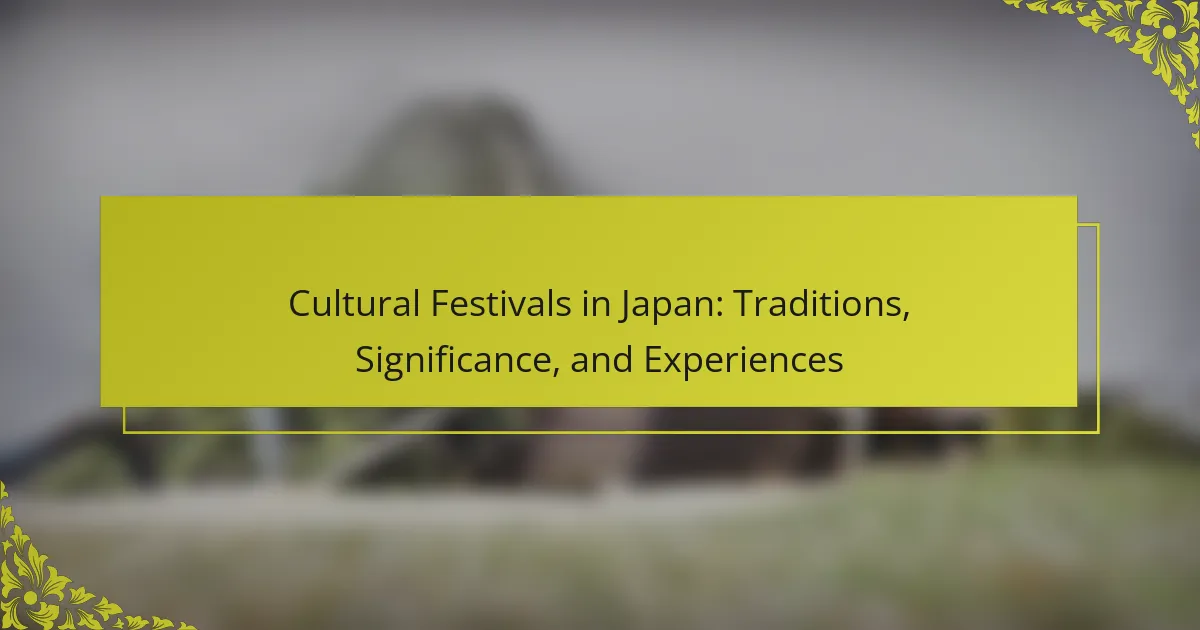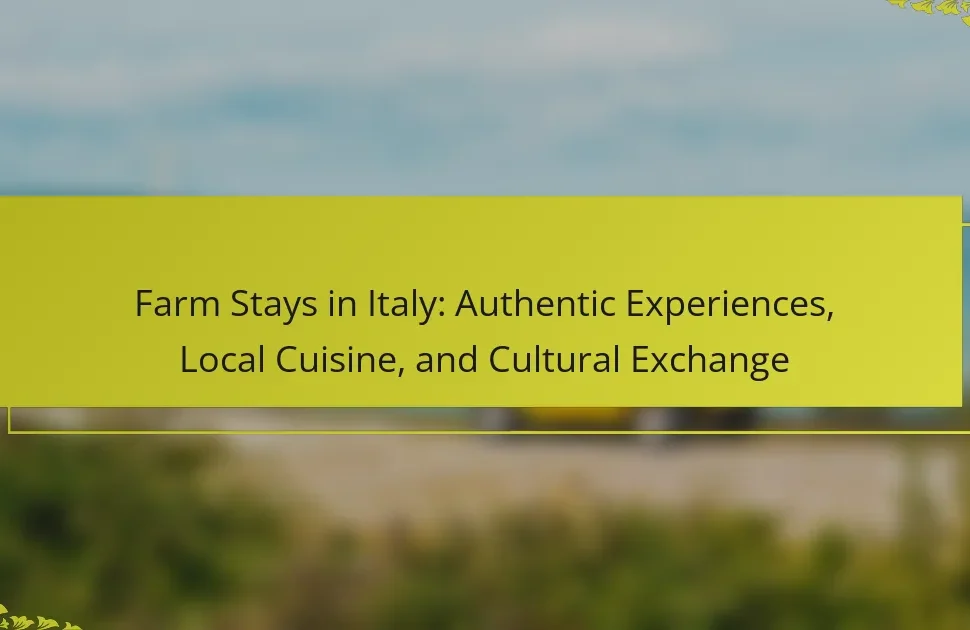Cultural festivals in Japan offer unique experiences that highlight the country’s rich traditions and community significance. Explore notable festivals like Gion Matsuri and Tanabata, and discover the importance of traditional performances in preserving heritage. Learn how these events foster community identity and cohesion while showcasing diverse culinary highlights. Additionally, examine the modern influences shaping these festivals and the challenges they face in the 21st century.
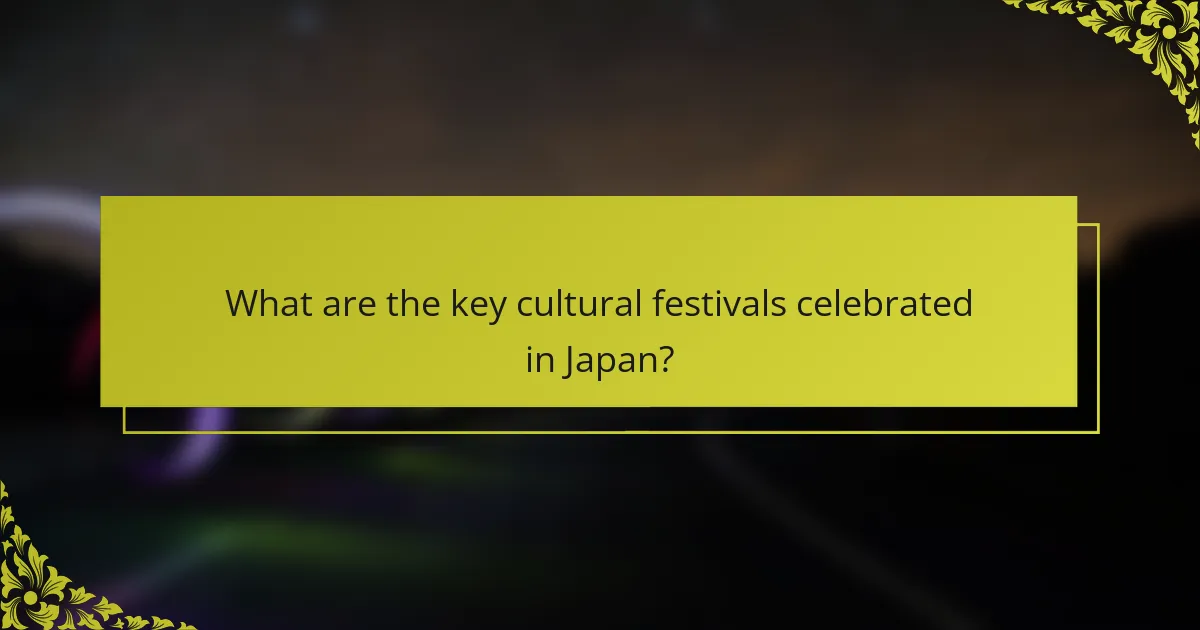
What are the key cultural festivals celebrated in Japan?
Japan celebrates numerous key cultural festivals that reflect its rich traditions and significance. Notable festivals include Gion Matsuri in Kyoto, renowned for its elaborate floats and processions, and Tanabata, celebrating the meeting of deities with beautiful decorations and wishes. The Nebuta Matsuri in Aomori features vibrant floats and energetic parades, while the Kanda Matsuri in Tokyo showcases traditional performances and historical significance. Each festival offers unique experiences, drawing locals and tourists alike to partake in Japan’s cultural heritage.
How do seasonal changes influence festival timing?
Seasonal changes significantly influence the timing of cultural festivals in Japan. Festivals often align with agricultural cycles, such as rice planting and harvest seasons. For example, the cherry blossom festivals occur in spring when the sakura trees bloom, symbolizing renewal. Autumn festivals celebrate harvests, reflecting gratitude for bountiful crops. Weather conditions and traditional calendars also dictate festival dates, ensuring cultural practices remain relevant to seasonal changes. This connection enhances community engagement and preserves cultural heritage.
Which festivals are unique to specific regions?
Japan hosts several unique cultural festivals, each reflecting regional traditions and significance. Notable examples include the Gion Matsuri in Kyoto, famous for its elaborate floats, and the Nebuta Matsuri in Aomori, known for vibrant illuminated floats. The Sapporo Snow Festival showcases stunning ice sculptures, while the Takayama Matsuri features ornate festival floats and traditional performances. Each festival offers distinct experiences tied to local heritage and seasonal celebrations.
What are the historical origins of major festivals?
Cultural festivals in Japan have historical origins rooted in Shinto and Buddhist traditions. These festivals, known as “matsuri,” celebrate seasonal changes, harvests, and religious ceremonies. For example, the Gion Matsuri in Kyoto dates back to the 9th century and honors the deity of the Yasaka Shrine. Many festivals incorporate unique attributes like floats, traditional costumes, and local cuisine, enhancing community participation and cultural identity. The significance of these festivals lies in their role in preserving history, fostering social bonds, and promoting tourism.
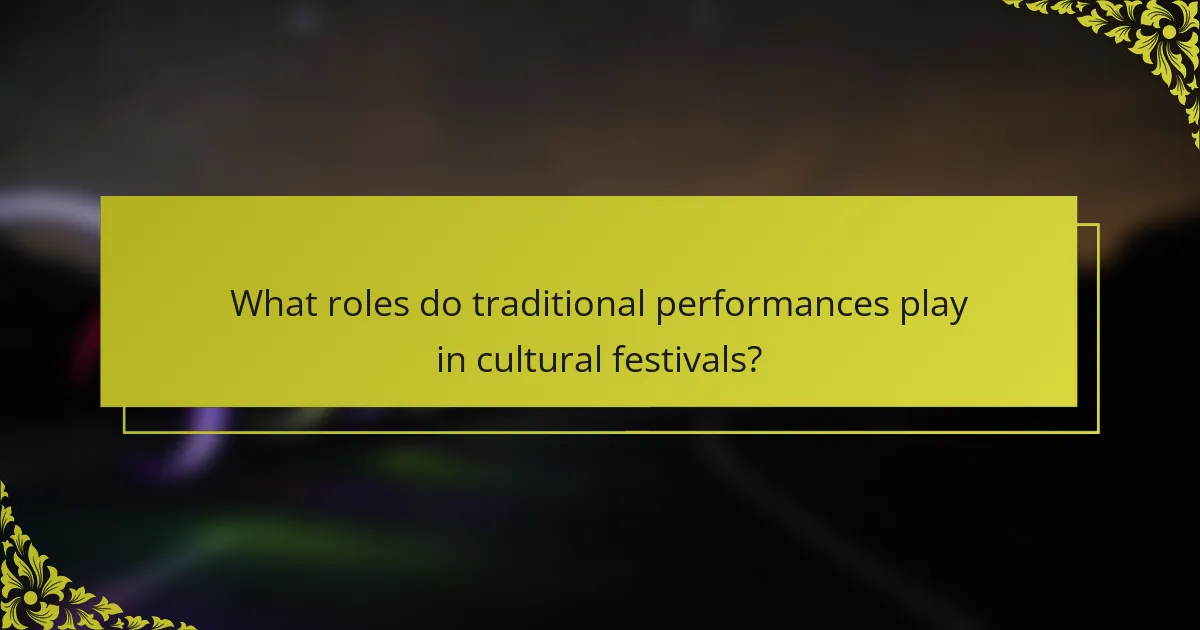
What roles do traditional performances play in cultural festivals?
Traditional performances play a vital role in cultural festivals by preserving heritage and fostering community identity. These performances, such as dance and music, reflect historical narratives and regional diversity. They engage audiences, creating a shared experience that strengthens social bonds. Additionally, traditional performances attract tourism, contributing to local economies and cultural exchange. These elements highlight the significance of traditional performances in celebrating Japan’s rich cultural tapestry.
How do music and dance enhance the festival experience?
Music and dance significantly enhance the festival experience by fostering community connection and cultural expression. Traditional Japanese festivals feature unique musical styles and vibrant dance forms that reflect local heritage. These elements create an immersive atmosphere, encouraging participation and emotional engagement. For example, the Awa Odori dance, characterized by its lively rhythm and communal participation, illustrates how movement and sound unite festival-goers. Additionally, live performances often evoke nostalgia and pride, reinforcing cultural identity.
Which traditional costumes are commonly worn during festivals?
Traditional costumes commonly worn during festivals in Japan include the kimono, yukata, and hakama. The kimono is a formal garment often made of silk, showcasing intricate designs. The yukata is a casual cotton robe typically worn during summer festivals. The hakama is a pleated skirt-like garment, often worn by men during ceremonial events. Each costume reflects Japan’s rich cultural heritage and is integral to festival experiences.

How do festivals contribute to community identity and cohesion?
Cultural festivals in Japan significantly enhance community identity and cohesion. These events foster a shared sense of belonging through the celebration of local traditions and customs.
Festivals like Gion Matsuri and Tanabata not only showcase regional heritage but also encourage participation from diverse community members. This collective involvement strengthens social bonds and promotes cultural continuity.
Moreover, festivals often serve as platforms for local artisans and businesses, boosting the economy and reinforcing community pride. The vibrant displays of culture and tradition create lasting memories, further solidifying community ties.
In summary, cultural festivals in Japan play a vital role in shaping community identity, fostering unity, and promoting local culture through shared experiences.
What are the social impacts of participating in local festivals?
Participating in local festivals fosters community bonding, cultural appreciation, and economic benefits. Festivals encourage social interaction and strengthen relationships among residents. They also promote local traditions, enhancing cultural identity and pride. Moreover, festivals attract tourism, boosting local businesses and creating job opportunities.
How do festivals promote cultural exchange among diverse groups?
Cultural festivals in Japan enhance cultural exchange by showcasing diverse traditions and fostering connections among participants. These events attract both locals and international visitors, promoting understanding and appreciation of varied customs.
Festivals like Hanami and Tanabata encourage interaction through shared experiences, such as traditional performances and culinary exchanges. This interaction cultivates a sense of community and respect among different cultural groups.
Moreover, the unique attributes of each festival, such as specific rituals or regional foods, provide opportunities for deeper engagement. Visitors often leave with enriched perspectives and a greater appreciation for cultural diversity.
As a result, cultural festivals serve as vital platforms for dialogue, collaboration, and mutual respect among diverse groups, significantly contributing to social cohesion.
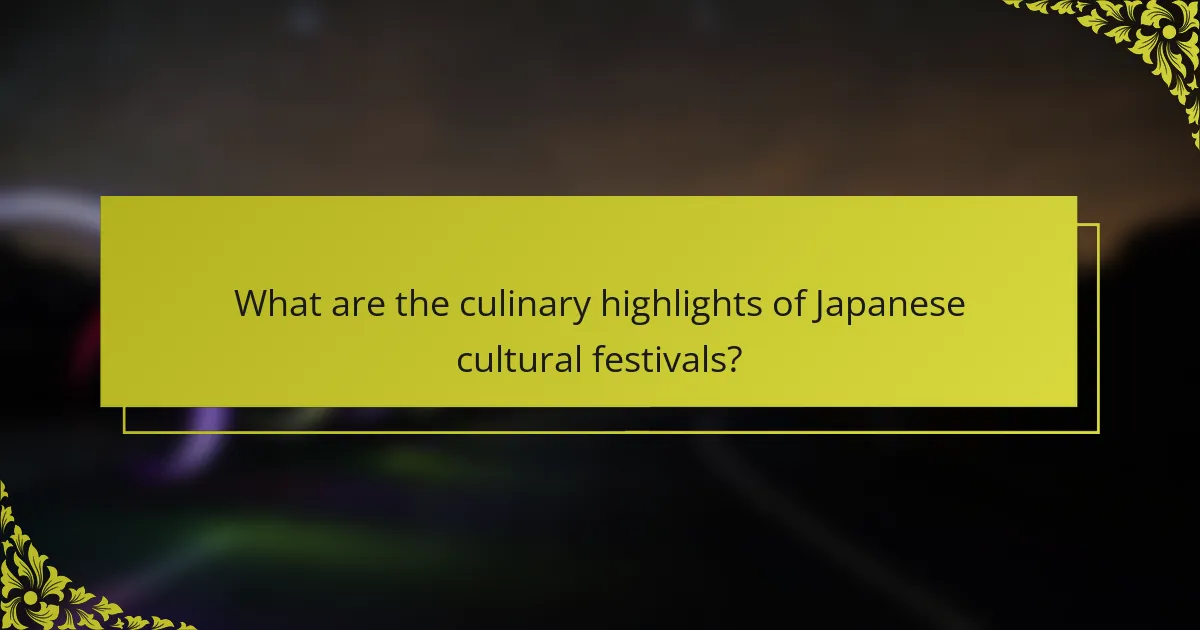
What are the culinary highlights of Japanese cultural festivals?
Japanese cultural festivals showcase diverse culinary highlights, emphasizing seasonal ingredients and traditional recipes. Popular festival foods include yakitori, takoyaki, and sweet mochi. Each dish reflects local customs and flavors, enhancing the festive atmosphere. For example, during the Gion Matsuri, participants enjoy yudofu, a dish symbolizing harmony. These culinary experiences are integral to the cultural significance of festivals, fostering community and tradition.
Which traditional foods are associated with specific festivals?
Traditional foods associated with specific festivals in Japan include mochi for New Year’s, sakura mochi for Hanami, and dango for the Doll Festival. Each dish reflects cultural significance and seasonal ingredients. Mochi symbolizes prosperity, while sakura mochi celebrates cherry blossoms, and dango represents family unity. These foods enhance the festive experience and connect participants to their heritage.
How do food stalls enhance the festival atmosphere?
Food stalls significantly enhance the festival atmosphere by providing diverse culinary experiences. They offer traditional dishes that reflect local culture, creating a vibrant sensory environment. The sights, sounds, and aromas of food preparation contribute to the festive ambiance. Moreover, food stalls encourage social interaction, as attendees gather to enjoy meals together. These stalls often feature unique regional specialties, showcasing the cultural richness of Japanese festivals.
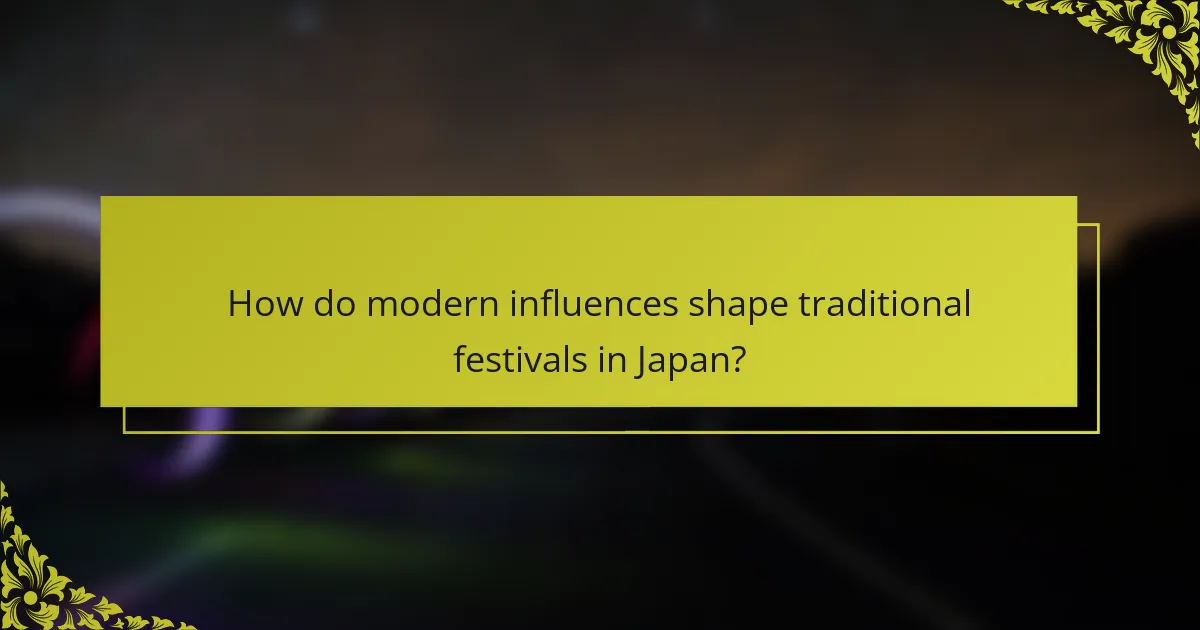
How do modern influences shape traditional festivals in Japan?
Modern influences increasingly shape traditional festivals in Japan by incorporating contemporary themes and technology. Festivals now blend ancient customs with modern entertainment, attracting diverse audiences.
For example, the Gion Matsuri in Kyoto merges traditional floats with light displays, enhancing visual appeal. Social media promotes festivals, encouraging participation and global awareness.
Moreover, sustainability initiatives influence festival practices, leading to eco-friendly decorations and waste management. Unique collaborations with local businesses promote regional culture, creating a dynamic festival experience.
As a result, while preserving heritage, these festivals evolve to reflect current societal trends and values.
What contemporary trends are emerging in festival celebrations?
Contemporary trends in festival celebrations in Japan include increased sustainability, digital engagement, and experiential offerings. Festivals are now focusing on eco-friendly practices, such as reducing waste and promoting local crafts. Digital platforms enhance participation, allowing global audiences to engage virtually. Experiential elements, like interactive art installations and immersive performances, create memorable experiences that attract younger generations. These trends reflect a shift towards inclusivity and innovation in cultural expressions.
How do festivals adapt to urbanization and globalization?
Cultural festivals in Japan adapt to urbanization and globalization by incorporating modern elements while preserving traditional practices. They blend local customs with global influences, enhancing participation and outreach.
Urban settings provide platforms for larger audiences, enabling festivals to showcase diverse cultures. For instance, festivals now utilize digital marketing to attract international visitors. Globalization introduces new cultural exchanges, enriching the festival experience with international cuisine and performances.
Additionally, festivals often respond to urban challenges by promoting sustainability. Initiatives include waste reduction and local sourcing, aligning with contemporary environmental concerns. This adaptability ensures that cultural festivals remain relevant and engaging in a rapidly changing world.
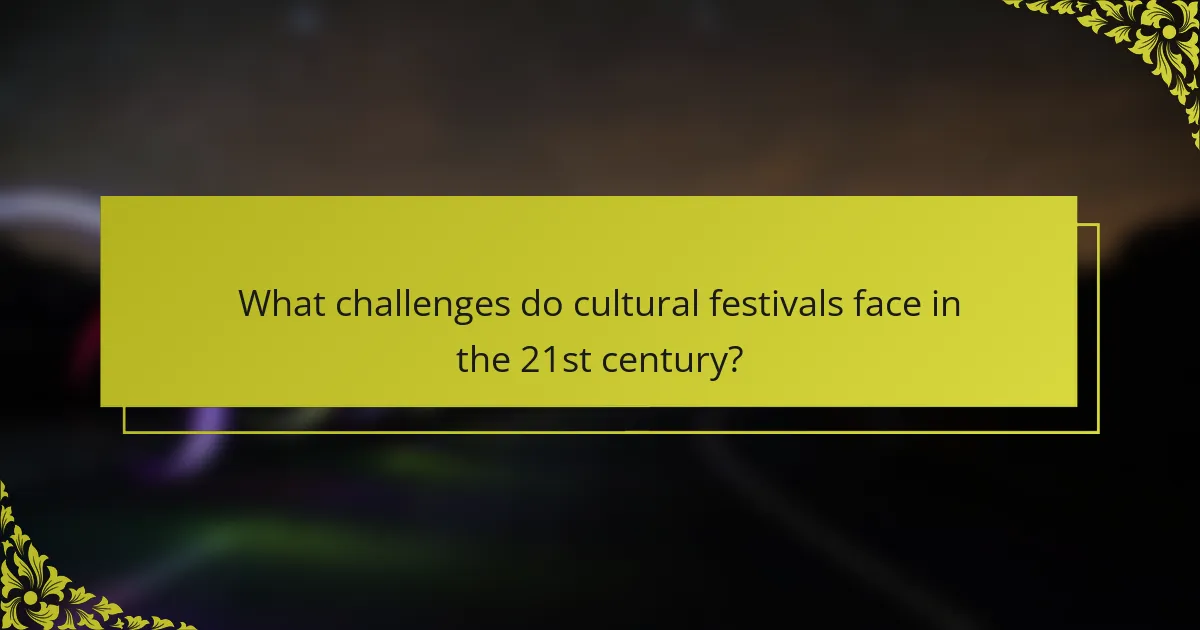
What challenges do cultural festivals face in the 21st century?
Cultural festivals in the 21st century face challenges such as globalization, declining participation, and funding issues. Globalization can dilute traditional practices, making it harder to maintain cultural authenticity. Declining participation, particularly among younger generations, threatens the viability of these festivals. Additionally, securing funding in an increasingly competitive environment poses a significant challenge for organizers. These factors collectively impact the significance and experiences associated with cultural festivals in Japan.
How do environmental concerns impact festival planning?
Environmental concerns significantly influence festival planning in Japan by promoting sustainability and community engagement. Organizers increasingly prioritize eco-friendly practices, such as waste reduction and energy efficiency. For example, many festivals now implement recycling programs and use renewable energy sources. This shift not only minimizes environmental impact but also enhances the cultural significance of festivals by aligning them with contemporary social values. Additionally, local communities often become more involved in planning, fostering a sense of ownership and responsibility towards their cultural heritage and environment.
What are the effects of tourism on local festivals?
Tourism positively influences local festivals by enhancing cultural exchange and economic growth. Increased visitor numbers often lead to higher participation in traditional events, preserving and revitalizing local customs. Additionally, tourism can provide funding for festival activities, improving their quality and reach. However, it may also lead to commercialization, potentially diluting the authenticity of cultural expressions. The balance between preservation and adaptation is crucial for maintaining the significance of these festivals in Japan.

Which festivals are considered must-see experiences for visitors?
Cultural festivals in Japan that are must-see experiences for visitors include the Gion Matsuri in Kyoto, the Nebuta Matsuri in Aomori, and the Sapporo Snow Festival. Each festival showcases unique traditions and cultural significance.
The Gion Matsuri, celebrated in July, features elaborate floats and traditional clothing, highlighting Kyoto’s rich heritage. The Nebuta Matsuri, held in August, is famous for its vibrant illuminated floats and lively parades, representing Aomori’s local folklore. The Sapporo Snow Festival, occurring in February, displays stunning snow and ice sculptures, attracting millions of visitors annually.
These festivals not only provide entertainment but also offer deep insights into Japan’s cultural identity and community spirit.
What practical tips can enhance the festival experience for tourists?
To enhance the festival experience for tourists in Japan, consider these practical tips.
1. Research the festival schedule and plan your visit accordingly to avoid missing key events.
2. Engage with locals to gain insights into traditions and customs, enriching your understanding.
3. Try local cuisine at food stalls to experience authentic flavors unique to each festival.
4. Wear comfortable clothing and shoes for walking and standing during festivities.
5. Participate in traditional activities or workshops to immerse yourself in the culture.
6. Capture memories through photography, but be respectful of others and the environment.
How can attendees respectfully engage with local traditions?
Attendees can respectfully engage with local traditions by observing and participating in cultural practices with an open mind. Understanding the significance of rituals enhances appreciation. Dress appropriately and follow local customs to show respect. Engaging with locals through conversations can provide deeper insights into the cultural context. Always ask for permission before taking photos or participating in ceremonies to honor traditions.
What are common mistakes to avoid when attending a festival?
To avoid common mistakes at cultural festivals in Japan, plan ahead and respect local customs. Arriving unprepared can lead to missing out on key experiences.
1. Ignoring festival schedules can result in missing important events.
2. Disrespecting traditions may offend locals and diminish your experience.
3. Overpacking can make navigating crowded areas difficult.
4. Failing to learn basic Japanese phrases can hinder communication.
5. Neglecting to stay hydrated and fueled can lead to fatigue.
6. Underestimating travel time can cause you to miss festival highlights.
